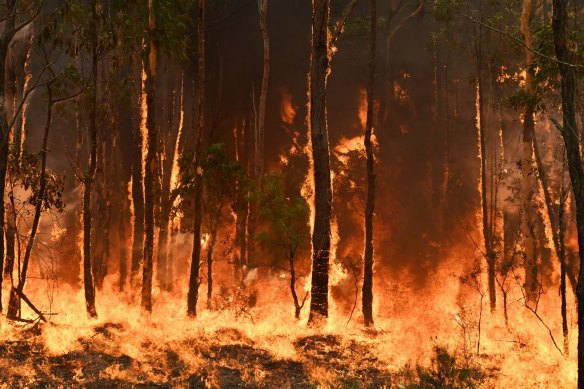Proactive Residential Property Defense: Leveraging the Insights of a BAL Report
Proactive Residential Property Defense: Leveraging the Insights of a BAL Report
Blog Article
How BAL Report Impacts Shrub Fire Security Measures
In the realm of bush fire defense, the Building Strike Level (BAL) record stands as a crucial device that substantially influences the security and resilience of buildings in fire-prone areas - BAL Report. The influence of a BAL evaluation expands much past simple paperwork; it works as the keystone for figuring out the ideal construction standards and fire security procedures essential to minimize the threats positioned by bushfires. As neighborhoods face increasingly severe fire seasons, comprehending just how the BAL report shapes these protective steps comes to be paramount for property owners, home builders, and policymakers alike
Recognizing the Bushfire Strike Level

Significance of BAL Record Analysis

In Addition, the BAL report analysis functions as a fundamental action in abiding by legal responsibilities and needs associated with bushfire defense. Regional councils and authorities often mandate the submission of a BAL report as part of the planning and building authorization process to guarantee that residential or commercial properties are effectively guarded versus bushfire threats. Falling short to perform a detailed BAL record analysis can lead to poor defense actions, leaving properties vulnerable to devastating bushfire events.
Building And Construction Standards Based on BAL
An extensive understanding of the Bushfire Strike Degree (BAL) enables homeowner to carry out building requirements tailored to their details threat account. Building criteria based upon BAL are important in reducing the impact of bushfires on properties. The BAL score categorizes the possible danger a property encounters during a bushfire on a range from BAL-Low to BAL-FZ (Flame Area) Each BAL degree corresponds to details building needs detailed in the Australian Conventional AS3959-2018 Construction of Structures in Bushfire-Prone Areas. For circumstances, residential or commercial properties classified as BAL-Low might only need basic actions such as clearing particles and preserving yards, while those in higher BAL groups need more durable measures like ash screens, fireproof materials, and secured windows. Sticking to these building and construction standards not only boosts the structural durability of the residential property yet also improves the general security of homeowners during a bushfire event. Home owners need to very carefully consider their BAL score and abide with the equivalent building and construction criteria to appropriately guard their occupants and homes.
Carrying Out Fire Security Measures
With the structure of building and construction standards based upon Bushfire Assault Level (BAL) in position, the focus currently moves in the direction of the sensible application of fire protection procedures to fortify homes versus bushfire dangers. Implementing fire defense steps entails a combination of passive and energetic methods to enhance the durability of buildings in bushfire-prone locations. Passive procedures include making use of fire-resistant structure materials, mounting ash guards on vents, sealing voids in roofs and walls, and preserving a clear space around the residential property without combustible Get the facts greenery. Energetic measures include having firefighting equipment conveniently available, such as pipes and water pumps, along with creating a defendable area around the property by removing plant life and having a well-maintained yard. Additionally, creating an evacuation plan and ensuring all locals know emergency situation procedures are important parts of reliable fire defense measures. By integrating both passive and active methods, residential or commercial properties can substantially lower their susceptability to bushfire incidents and increase the safety of occupants.
Shielding Houses Against Bushfires
Properly securing homes against the devastating influences of bushfires needs a comprehensive and aggressive approach to fire defense actions. House owners living in bushfire-prone areas should prioritize the implementation of different techniques to enhance their residential or commercial property's resilience versus wildfires. One essential facet is creating a defensible area around the home by keeping a clear zone without combustible materials. This consists of routinely cutting plant life, removing dead plants, and making sure a secure range between structures and trees. Mounting fireproof roofing materials can likewise dramatically reduce the risk of ash strikes and straight fire contact. Additionally, sealing voids and vents to avoid ember invasion, in addition to integrating fireproof windows and doors, can aid strengthen the home's protection versus bushfires. Buying a reliable water source, such as a well-maintained sprinkler system or a specialized water storage tank, is critical for providing water throughout fire emergency situations - BAL Report. By welcoming an aggressive position and incorporating these protective steps, house owners can dramatically increase their chances of safeguarding their homes against bushfires.
Verdict
In final thought, the Bushfire Attack Degree (BAL) report plays an essential duty in establishing the required protection procedures against bushfires. By assessing the BAL, building and construction requirements can be tailored to minimize the dangers and guarantee the safety and security of homes in fire-prone locations. Executing fire defense steps based upon the other BAL report is crucial in protecting buildings from prospective bushfire hazards. It is critical for house owners to focus on BAL evaluations and abide by recommended building and construction standards to enhance bushfire durability.
In evaluating bushfire danger to properties, understanding the Bushfire Assault Degree (BAL) is a vital part for executing efficient protection steps. On the whole, a clear see here understanding of the Bushfire Attack Level is crucial for implementing appropriate protection procedures and mitigating the impact of bushfires on properties.

Report this page